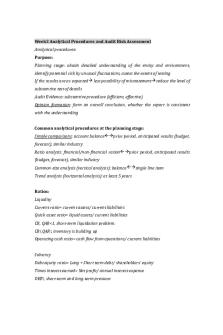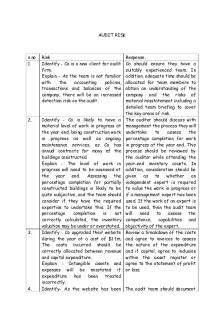Audit Risk Model PDF

| Title | Audit Risk Model |
|---|---|
| Author | Ra sam |
| Course | Auditing 1 |
| Institution | Royal Melbourne Institute of Technology |
| Pages | 3 |
| File Size | 111 KB |
| File Type | |
| Total Downloads | 87 |
| Total Views | 147 |
Summary
Audit Risk Model...
Description
Audit Risk Inherent Risk, Control Risk & Detection Risk
Model
Contents:
1. 2. 3. 4. 5. 6. 7. 8. 9.
Definition Explanation Model Components Inherent Risk Control Risk Detection Risk Application Example
Definition Audit Risk is the risk that an auditor expresses an inappropriate opinion on the financial statements.
Explanation Audit risk is the risk that an auditor issues an incorrect opinion on the financial statements. Examples of inappropriate audit opinions include the following:
Issuing an unqualified audit report where a qualification is reasonably justified;
Issuing a qualified audit opinion where no qualification is necessary;
Failing to emphasize a significant matter in the audit report; Providing an opinion on financial statements where no such opinion may be reasonably given due to a
significant limitation of scope in the performance of the audit.
Model Audit Risk = Inherent Risk x Control Risk x Detection Risk Audit risk may be considered as the product of the various risks which may be encountered in the performance of the audit. In order to keep the overall audit risk of engagements below acceptable limit, the auditor must assess the level of risk pertaining to each component of audit risk.
Components Explanation of the 3 elements of audit risk is as follows:
Inherent Risk Inherent Risk is the risk of a material misstatement in the financial statements arising due to error or omission as a result of factors other than the failure of controls (factors that may cause a misstatement due to absence or lapse of controls are considered separately in the assessment of control risk).
Inherent risk is generally considered to be higher where a high degree of judgment and estimation is involved or where transactions of the entity are highly complex. For example, the inherent risk in the audit of a newly formed financial institution which has a significant trade and exposure in complex derivative instruments may be considered to be significantly higher as compared to the audit of a well established manufacturing concern operating in a relatively stable competitive environment.
Control Risk Control Risk is the risk of a material misstatement in the financial statements arising due to absence or failure in the operation of relevant controls of the entity. Organizations must have adequate internal controls in place to prevent and detect instances of fraud and error. Control risk is considered to be high where the audit entity does not have adequate internal controls to prevent and detect instances of fraud and error in the financial statements. Assessment of control risk may be higher for example in case of a small sized entity in which segregation of duties is not well defined and the financial statements are prepared by individuals who do not have the necessary technical knowledge of accounting and finance.
Detection Risk Detection Risk is the risk that the auditors fail to detect a material misstatement in the financial statements. An auditor must apply audit procedures to detect material misstatements in the financial statements whether due to fraud or error. Misapplication or omission of critical audit procedures may result in a material misstatement remaining undetected by the auditor. Some detection risk is always present due to the inherent limitations of the audit such as the use of sampling for the selection of transactions. Detection risk can be reduced by auditors by increasing the number of sampled transactions for detailed testing.
Application Audit risk model is used by the auditors to manage the overall risk of an audit engagement. Auditors proceed by examining the inherent and control risks pertaining to an audit engagement while gaining an understanding of the entity and its environment. Detection risk forms the residual risk after taking into consideration the inherent and control risks pertaining to the audit engagement and the overall audit risk that the auditor is willing to accept. Where the auditor's assessment of inherent and control risk is high, the detection risk is set at a lower level to keep the audit risk at an acceptable level. Lower detection risk may be achieved by increasing the sample size for audit testing. Conversely, where the auditor believes the inherent and control risks of an engagement to be low, detection risk is allowed to be set at a relatively higher level.
Example ABC is an audit and assurance firm which has recently accepted the audit of XYZ. During the planning of the audit, engagement manager has noted the following information regarding XYZ for consideration in the risk assessment of the assignment:
XYZ is a listed company operating in the financial services sector
XYZ has a large network of subsidiaries, associates and foreign branches
The company does not have an internal audit department and its audit committee does not include any members with a background in finance as suggested in the corporate governance guidelines
It is the firm's policy to keep the overall audit risk below 10%
Inherent risk in the audit of XYZ's financial statements is particularly high because the entity is operating in a highly regularized sector and has a complex network of related entities which could be misrepresented in the financial statements in the absence of relevant financial controls. The first audit assignment is also inherently risky as the firm has relatively less understanding of the entity and its environment at this stage. The inherent risk for the audit may therefore be considered as high. Control risk involved in the audit also appears to be high since the company does not have proper oversight by a competent audit committee of financial aspects of the organization. The company also lacks an internal audit department which is a key control especially in a highly regulated environment. The control risk for the audit may therefore be considered as high. If inherent risk and control risk are assumed to be 60% each, detection risk has to be set at 27.8% in order to prevent the overall audit risk from exceeding 10%. Working Audit Risk = Inherent Risk x Control Risk x Detection Risk 0.10 = 0.60 x 0.60 x Detection Risk 0.10 0.36
=
Detection
Risk
=
0.278
=
27.8%...
Similar Free PDFs

Audit Risk Model
- 3 Pages

09 Audit Risk Model & Materiality
- 19 Pages

Marketing Audit: Tesla Model 3
- 15 Pages

Ch05-audit-risk-and-materiality 1
- 18 Pages

Ch05 audit risk and materiality 1
- 18 Pages

Ch05-audit-risk-and-materiality 1
- 18 Pages

MODEL AUDIT PR 'YARDISTICK'
- 18 Pages
Popular Institutions
- Tinajero National High School - Annex
- Politeknik Caltex Riau
- Yokohama City University
- SGT University
- University of Al-Qadisiyah
- Divine Word College of Vigan
- Techniek College Rotterdam
- Universidade de Santiago
- Universiti Teknologi MARA Cawangan Johor Kampus Pasir Gudang
- Poltekkes Kemenkes Yogyakarta
- Baguio City National High School
- Colegio san marcos
- preparatoria uno
- Centro de Bachillerato Tecnológico Industrial y de Servicios No. 107
- Dalian Maritime University
- Quang Trung Secondary School
- Colegio Tecnológico en Informática
- Corporación Regional de Educación Superior
- Grupo CEDVA
- Dar Al Uloom University
- Centro de Estudios Preuniversitarios de la Universidad Nacional de Ingeniería
- 上智大学
- Aakash International School, Nuna Majara
- San Felipe Neri Catholic School
- Kang Chiao International School - New Taipei City
- Misamis Occidental National High School
- Institución Educativa Escuela Normal Juan Ladrilleros
- Kolehiyo ng Pantukan
- Batanes State College
- Instituto Continental
- Sekolah Menengah Kejuruan Kesehatan Kaltara (Tarakan)
- Colegio de La Inmaculada Concepcion - Cebu








